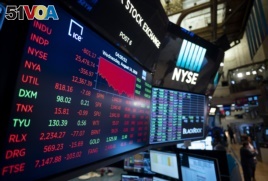16 August, 2019
Financial markets are giving warning signs of a recession. At the same time, the world economy is weakening, and the trade war between the United States and China has intensified.
All of which is raising concerns about the U.S. economy and about whether the country's record-breaking, 10-year expansion is nearing an end.
On Wednesday, a change in interest rates caused many investors to worry: The interest rate on the 10-year U.S. Treasury bond briefly dropped below the rate on the 2-year Treasury bond for the first time since 2007.
Usually, investors earn higher interest on longer-term bonds than on short-term ones. Put another way, the U.S. government will usually pay more interest to investors who are willing to let out their money for longer periods.
So, when longer-term Treasurys pay less than shorter-term ones, economists call it an inverted yield curve. An inverted curve suggests that investors expect the economy to slow so much that the U.S. central bank will soon feel forced to cut short-term rates to try to support the economy.
This is a sign of economic pessimism. Inverted curves are very good at predicting recessions: They have happened before in each of the past five recessions.
The inversion sent stock prices down a lot on Wednesday. The leading measure of U.S. stocks, the Dow Jones Industrial Average, fell 800 points, or 3%. An inversion, however, does not say when a recession will arrive. In the past, there have been about two years between an inversion and a recession.
So are we nearing a recession?
Many economists worry that chances of a recession are rising. Julia Coronado is the chief economist at MacroPolicy Perspectives, which follows the U.S. economy. She sees a 40% probability of a recession within the next 12 months. Last month, she thought the likelihood was 30%.
Her concerns, and the worries of other economists, are partly the result of the U.S.-China trade war. The trade war appears to have persuaded many businesses not to expand or invest in new buildings and equipment. It is also harming Germany's export-led economy, which shrank between April and June of this year. In addition, Britain plans to leave the European Union on October 31, while Japan and South Korea are having their own trade fight.

A TV screen shows the numbers after the closing bell at the New York Stock Exchange (NYSE) on August 14, 2019 in New York City.
The U.S. government threatened new 10% tariffs on $300 billion of mostly consumer goods from China, but then announced a delay until December. That is because President Donald Trump and his administration do not want prices to rise before the Christmas holiday shopping season. If the tariffs began immediately, it would force stores to raise their prices.
For now, most other U.S. economic signs do not point to recession. Employers are adding jobs, the unemployment rate remains near a 50-year low.
An inverted yield curve is not enough to say for sure there will be a recession, explained Eric Winograd. He is an economist at investment and search service AllianceBernstein.
"I would want to see other signals that point to that, but we're not seeing them right now," he added.
What is a recession?
Generally, a recession is happening when Gross Domestic Product (GDP) shrinks for six months or longer. The GDP is the best measure of U.S. economic growth.
But that is not the official definition. The National Bureau of Economic Research is a private organization of economists that officially defines recessions. Those economists say a recession happens when there is a sharp drop in economic activity that lasts for "a few months." They measure the fall by looking at different kinds of economic information, including GDP, wages and jobs.
The bureau makes its declaration of a recession after studying recent economic reports. So, the economy can actually be in recession for some time before it is officially declared so. The bureau, for example, declared in November 2008 that the Great Recession had begun 11 months earlier.
What do economists watch for?
The most important sign of a weakening economy is the weekly number of people who, for the first time, request unemployment assistance from the government. People can receive the aid if they have lost their jobs through no fault of their own. So, if that number is rising, it means businesses are cutting jobs.
Last week, the number was very low: 209,000.
Economists also look at factory activity since people stop buying cars, refrigerators and other large goods when they are worried about their jobs or the economy.
How severe might a recession be?
It is hard to know the effect of a recession, but many economists think it will not be that bad. That is because many American families are in a better financial position now than before the Great Recession during the late 2000s.
Household debt is lower, and U.S. interest rates are really low.
I'm Susan Shand.
The Associated Press reported this story. Susan Shand adapted it for VOA Learning English. George Grow was the editor.
Write to us in the Comments Section or on 51VOA.COM.
________________________________________________________________
Words in This Story
inverted – v. to change the position, order, or relationship of things so that they are the opposite of what they had been
curve – n. a curved line on a graph that shows how something changes or is affected by one or more conditions
pessimism – n. a feeling or belief that bad things will happen in the future
consumer – n. a person who buys goods and services
fault – n. responsibility for a problem, mistake, bad situation